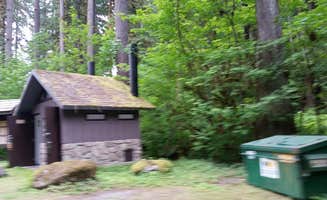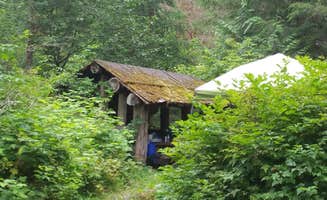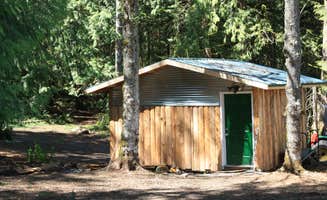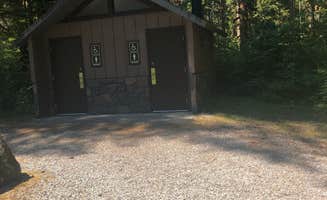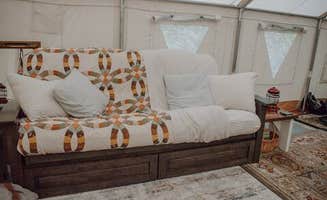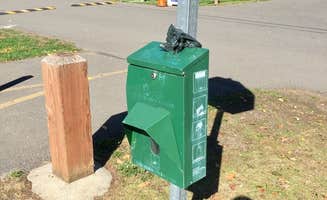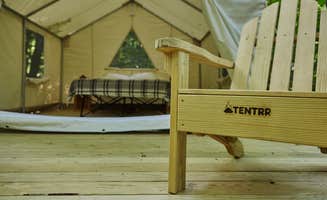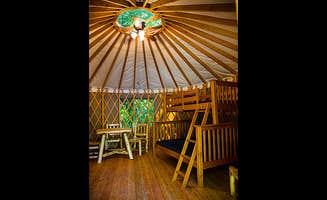Dispersed camping near Darrington, Washington sits at the gateway to Mount Baker-Snoqualmie National Forest, with elevations ranging from 500 to 7,000 feet throughout the region. Summer temperatures typically reach 70-85°F during day and drop to 45-55°F at night. Winter camping requires preparation for snow and freezing temperatures, with many campgrounds closing seasonally from late September through May.
What to do
River exploration: Access the Sauk River at Clear Creek Campground where swimming and fishing spots are readily available. The campground provides easy river entry points from several campsites. "The creek and the Sauk river are absolutely beautiful. There is so much wildlife in the area, keep an eye out," notes Douglas S., who recommends watching for wildlife while visiting.
Hiking ancient forests: The trails near Bedal Campground offer walks through old-growth trees just 6 miles down a gravel road. Many trails connect directly to campgrounds in the area. "The Trees here are Amazing! 21 campsites to choose from, with some availability to reserve. The sites are large, and there is a large old growth shelter available as well," shares Andrea R., highlighting the impressive forest surroundings.
Water activities: Several local lakes offer summer boating and fishing from May through September. At Swift Creek Campground, visitors can launch small watercraft from designated areas. "50 feet out into the lake and it makes beautiful scene," explains Lucas, describing the views when paddling on Baker Lake with Mount Baker visible in the background.
What campers like
Privacy between sites: Many campers appreciate the natural separation at Marble Creek Campground. Sites feature natural barriers and ample space between neighbors. "Campsites are super spacious and spread out, so it felt very private. No water, so pack yours in!" advises Olivia, who enjoyed the secluded feel despite being at a developed campground.
Clean facilities: Despite being vault toilets, most campgrounds maintain their restrooms regularly. Site hosts typically clean daily during peak season. "The bathrooms (vault toilets) are well maintained and clean, BUT BE AWARE THERE IS NO WATER HERE. Repeat, there is no water spouts here, so you'll have to bring all you need," warns Maria S. at Clear Creek Campground.
Proximity to mountain views: Many sites offer direct sightlines to surrounding peaks from camp or nearby hiking trails. The eastern campsites tend to have better mountain visibility. "If you're at Site 13, you'll see the many vehicles that stop and turn which is hilarious," mentions Kimmy G. at Clear Creek, noting how the scenic views often cause drivers to miss the campground entrance.
What you should know
Military ID requirement: Military Park Jim Creek Naval Radio Station requires proper identification for all visitors. Access is limited to military personnel, retirees, and DoD employees. "If your military or retired this hidden gem is a must do on the list. From its hiking trails through its old growth forrest, to its beautiful lake, Jim creek has something for everyone!" explains Jesse C., highlighting why this restricted-access site remains popular.
Water availability: Many sites lack potable water on-site. Visitors should bring 1-2 gallons per person per day. Multiple reviews across several campgrounds emphasize the importance of bringing your own water supply, as even campgrounds with water may have issues with taste or reliability.
Reservations recommended: From May to September, most campgrounds fill quickly, especially on weekends. Sites like Bedal and Marble Creek offer some first-come spots but fill by Friday afternoon. "We tried our luck with no reservations and we were able to score a spot for three nights. There were several sites available when we stayed there, but it was during the week," reports Danielle S., explaining her experience at Marble Creek.
Tips for camping with families
River safety: When camping with children near the Sauk or Cascade rivers, select sites away from steep banks. Swift Creek Campground offers family-friendly water access. "The swimming area is great for kids and adults, lots of places in the shade on the hill next to it with or without picnic tables, a few bathrooms nearby and water spigots," reports Lucas, describing the dedicated swimming area.
Mosquito preparation: Pack child-safe insect repellent for summer months when bugs are most active. Most campgrounds report moderate to heavy mosquito activity from June through August. "Mosquitoes will eat you alive," warns Joshua F. at Swift Creek Campground, emphasizing the need for proper protection.
Playground alternatives: While formal playgrounds are limited, several campgrounds offer open fields for games. At River Meadows Park, a large play area serves the campground. "Sites open up to a field, so kids kept running through our campsite and all around, that felt weird. But it had a community feel," explains Linda C., describing the family-friendly atmosphere.
Tips from RVers
Site length constraints: Most forest campgrounds accommodate RVs up to 30 feet, with limited sites for larger rigs. Thousand Trails Grandy Creek offers more spacious options for larger vehicles. "Outdoor pool is nice campground sights are too close together no privacy at all but a very nice place," notes Shawn P., comparing the KOA sites to more rustic options.
Road condition alerts: Forest service roads leading to many campgrounds feature gravel sections and occasional potholes. Check recent trip reports before driving large rigs to remote sites. "You have to drive out about 30 minutes on a gravel road with giant potholes from either direction to reach this campground," warns K W. about Bedal Campground.
Winter closures: Plan RV trips between May and September when most campgrounds are open. Many glamping options close to Darrington operate seasonally, with limited winter availability. Forest roads may be unmaintained or closed during winter months.


